Plants cannot survive unless they get enough light, water, minerals and air. Plants struggle for their existence in different habitats. The factors in these habitats may or may not help the plant to survive. For example, if the plant grows in marshy soil, they get more water and less air. On the contrary, if the plants grow in deserts they get less water and more air. So to make a living in all such kinds of environments plants must modify themselves. These plant organs perform some additional functions along with the normal functions. As a result some permanent changes occur in these plant organs. These permanent changes are called modifications.
Depending on the need, the entire organ or a part of the organ is modified. When permanent change occurs in the structure of a root to perform new functions suitable for the environment, it is called root modification. Roots in some plants change their shape and structure and become modified to perform functions other than absorption and conduction of water and minerals. They are modified to give support, store food and for respiration. The following is the description of the types of root systems,
Storage roots: Some amount of the food synthesized by the plant is utilized for the immediate requirements and the remaining food is stored in their roots for future purposes. Due to the accumulation of the stored food, the roots get swollen to become fleshy and tuberous. Hence these roots are also called as tuberous roots.
The roots of most of the biennial plants (plants which grow for two years or two seasons) are modified into storage roots. Depending on the shape they attain after the storage, they are named as one of the following,
Spindle shaped- Also called as fusiform shaped. Example: Raphanus sativus (Radish)

Cone shaped- Also called as conical shaped. Example: Daucus carota (Carrot)
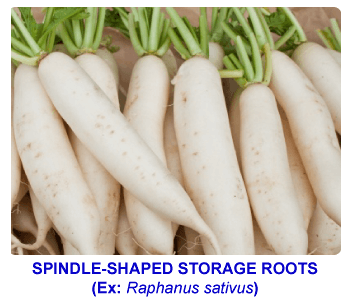
Top shaped- Also called as Napiform shaped. Example: Beta vulgaris (Beet root)
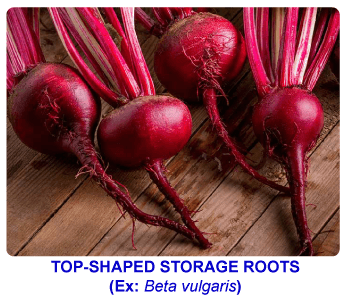
Moniliform- Also called as beaded roots. Example: Momordica (Bittergourd)
Annulated- These roots are seen in Psychotria
Nodulose- These roots are seen in Curcuma amada (Mango ginger) and Costus
Exceptions-
Why are root crops harvested only during the end of first year?
As these modified storage roots are rich in nutrition, they are termed as root crops. The biennials show vegetative growth in the first year or first season during which they synthesize the food materials and store in the roots. During the second year or the next season the plants utilize the food material for producing flowers, fruits and seeds. Because of this reason, usually root crops are harvested at the end of first year.
Epiphytic roots: The other names of these roots are Velamen roots, hygroscopic roots and aerophytic roots. The smaller plants in the evergreen forests do not get sufficient sunlight for their growth. These plants take shelter on the branches of big trees to obtain more sunlight. Such plants which take shelter on the big plants are called epiphytes and their roots are called epiphytic roots.
Example: Members of orchidaceae family (Vanda)
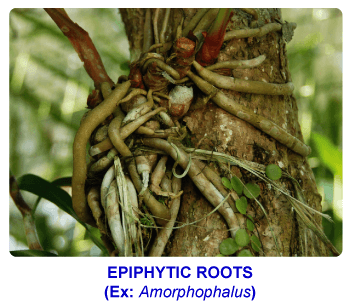
The epiphytes have two kinds of roots namely velamen roots and clinging roots
Velamen roots- They are long, thick and branched roots. They hang freely in air. These roots do not produce root hairs. The velamen roots contain a special, multilayered, dead hygroscopic epidermal tissue called velamen tissue. This tissue absorbs moisture from the atmosphere just like blotting paper
Clinging roots- They are short, comparably thin and branched roots. They are useful for fixing the plant on the branches of the host roots.
Epiphytic plants do not have direct contact with the soil, so they do not get continuous supply of water. Therefore epiphytes show many xerophytic adaptations. Plants growing in the habitats where there is scarcity of water and also the soil is physiologically dry.
Photosynthetic roots: In some epiphytes like Taeniophyllum the stems and leaves are absent. The roots of these plants become aerial, flattened, ribbon-like and green colored structures. These modified roots absorb moisture from the atmosphere and also synthesize food materials by carbon assimilation. Hence, these roots are also known as assimilatory roots.
Example: Podostemon, Tinospora and Trapa

Respiratory roots: The other names of these roots are breathing roots, Knee-roots and pneumatophores. Mangroves live in marshy and saline soil, so their roots will not get enough oxygen supply for respiration. Also mangroves suffer from lack of oxygen because these soils are water logged. So mangrove plants produce special aerial branches from the roots. These aerial roots possess minute pores which help in the absorption of oxygen from air. These pores are called pneumatothodes and the roots bearing these pores are called pneumatophores. They are also called as respiratory roots or breathing roots.
Example: Rhizophora and Avicennia
*Another aquatic example is a hydrophyte Jussiaea. Here the aerial roots become spongy and porous. They act as breathing roots apart from helping the plants to float on water. These roots are also known as spongy respiratory roots.

Nodular roots: The roots of leguminous plants show small nodule like structures called as nodular roots. The nodules are inhabited by colonies of rod shaped, nitrogen fixing bacteria called Rhizobium. Normally higher plants cannot utilize atmospheric nitrogen directly as it is diatomic. So this bacterium absorbs atmospheric nitrogen and converts it into ammonia and supplies to the host plant. In return, the bacterium receives food and shelter from the host plant. This type of mutual relationship between two different organisms is called symbiosis. The root nodules also contain a pink colored pigment called leg-hemoglobin.
Example: Arachis and Dolichos
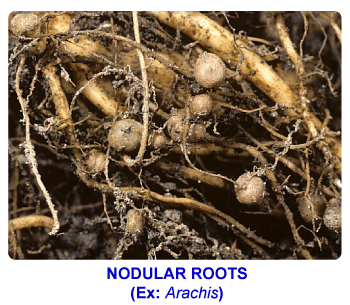
Plants with nodules are used as green manure because they can fix atmospheric nitrogen and thereby increase nitrogen content in the soil.
These roots are red in colour due to the presence of leg-haemoglobin.
The nodules are inhabited by nitrogen fixing bacteria called Rhizobium leguminosarum.
It converts atmospheric nitrogen into nitrates and supply them to the plant.
In turn Rhizobium gets nutrients and shelter from the plant. This type of association between the bacterium and leguminous plant for mutual benefit is known as symbiosis and the organisms involved are called symbionts.
This association is also called mutualism which is obligatory for both i.e., for bacteria and leguminous root.
Parasitic roots: The plants which depend on other plants are called as parasitic plants. Here the plant which gives shelter and food material to the parasite is called as the host plant. Parasitic plants produce special adventitious roots called as parasitic roots or haustoria which penetrate into the roots or shoots of the host plant to absorb food and other required nutrients. Based on the site of penetration the parasites can be named as stem parasites (when the parasite depends on the stem of the host plant) or root parasites (when the parasite depend on the root of the host plant).
When the parasite depends on the host only for water and minerals, it is called as partial parasite or semi parasite or incomplete parasite. On the other hand when the parasite absorbs both water, food and minerals from the host, it is called complete or total parasite.
Partial stem parasites:
Complete stem parasites:
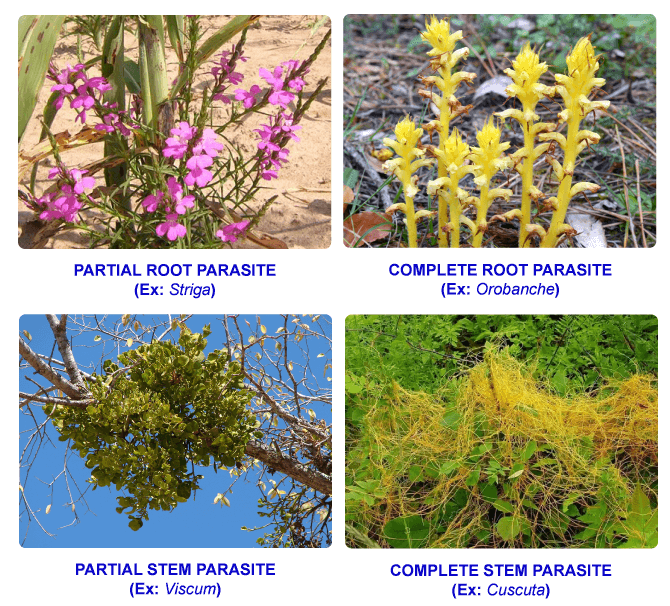
Partial root parasites:
Complete root parasites:
Prop roots
Example: Ficus benghalensis

Stilt roots

Buttress roots
Example: Terminalia, Bombax, Ceiba

Climbing roots
Example: Monstera

Balancing Roots or Floating roots
Example: Pistia, Eichornia

Contractile roots
Example: Amorphophallus

Reproductive roots
Example: Murraya, Millingtonia
Mycorrhiza or Fungal roots:
Example: Monotropa (Indian pipe plant)

Hope you have liked this post.
Please share it with your friends through below links.
All the very best from Team Studyandscore
“Study well, Score more…”
- Share with your friends! -
Login to post your comment here...
- or with social Account -